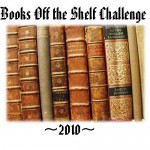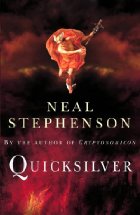Review: ‘Quicksilver’ by Neal Stephenson

 Title: Quicksilver: Book I of the Baroque Cycle
Title: Quicksilver: Book I of the Baroque Cycle
Author: Neal Stephenson
Published: Arrow, 2004, pp. 927. Originally published 2003
Genre: Alternative history
Blurb: A novel of history, adventure, science, invention, sex, absurdity, piracy, madness, death and alchemy that sweeps across continents and decades, upending kings, armies, religious beliefs and all expectations. Bringing a remarkable age and its momentous events to vivid life — in an historical epic populated by Samuel Pepys, Isaac Newton, William of Orange, Benjamin Franklin and King Louis XIV — Quicksilver is an extraordinary achievement from one of the most remarkable and original writers of our time.
When, where and why: I picked this book up from a little stand of second hand books in the basement of the Treasurer’s House, a National Trust property in York. I visited it shortly after I had finished my MA so it’s been on my shelves for a little over a year now, making it book 33/50 for my Books Off the Shelf Challenge. I had accidentally bought the second book in this trilogy earlier in the year without realising it was book two, so I snapped this one up when I saw it.
What I thought: If, from reading the blurb from the back of this book, you think it sounds a bit diverse and complicated you would be absolutely correct. Quicksilver is a mammoth work which covers so many areas that it can get out of hand. In fact, reading Quicksilver, I was reminded of that nursery rhyme:
There was a little girl and she had a little curl
Right in the middle of her forehead
When she was good, she was very, very good
And when she was bad, she was horrid.
When this book is bad, it is tedious, confusing, dull and frustrating, but when it’s good it’s fantastic. I actually started it way back in February (which explains my excessively low book count for this month) but set it aside because I couldn’t take it any more: I found it opaque and thought it had too many storylines which seemed completely unconnected with too many characters that I didn’t particularly like. I only picked it up again in order to finish it so that I could get rid of the terrible thing. However, evidently the break was exactly what I needed, as this time around I found it fascinating and everything clicked into place, and now I’m looking forward to reading the rest of the Baroque Cycle.
The book was still confusing and was by no means an easy read. It is written in several different forms: regular prose, playscript style and in letters where the real message is hidden in italics among the main body of the missive. The narrative skips about from one character to another, in between countries and passing over chunks of time, so Stephenson keeps you on your toes constantly. But this time I enjoyed the challenge rather than being frustrated by it. I think part of the reason that it feels so difficult is that it’s such a large book that it can be easy to find it overwhelming. I noticed that the novel is in fact divided into three books, and I think that when I approach The Confusion, the rather appropriately named second volume of the Baroque Cycle, I will take a break to read something palate cleansing in between the composite books so that I don’t become fatigued and disillusioned as I did with Quicksilver. This seems a far more sensible way to tackle these massive, dense books and I would recommend this approach to anyone else.
Although there were lulls in between the good bits, when Stephenson gets it right his writing is perfectly pitched, wry, deadly accurate and very quoteable:
Daniel felt about the place [the Royal Society] as a Frenchman felt about the French language, which was to say that it all made sense once you understood it, and if you didn’t understand it, then to hell with you. (p. 784)
It is full of encoded stereotypes, contemporary and modern, and biting satire. He has an impressive way with words, and hopefully I’ll be able to appreciate this a bit more in future volumes now that I’ve learnt to stop fretting about the plot(s).
I’ve been a bit nervous about reading alternative history in the past, primarily because my historical knowledge of any given period isn’t sufficiently complete for me to be able to distinguish exactly what is history and what is the author’s own deliberate departure from it. In order to verify everything that went on in Quicksilver I would have to research for years, and I have a huge respect for the effort that Neal Stephenson has obviously put into crafting his slightly off-kilter seventeenth century, but at any rate the events of the book were so bizarre (I seem to recall chasing ostriches in Vienna, although that was in February’s section so I may well be wrong) that I decided to throw caution to the winds and just to go with it. I think that is the best attitude to have when reading this book, as its wonder doesn’t rest on what is accurate and what isn’t but on the world full of intrigue, real or not, that Stephenson has created.
Quicksilver is hard work to read, but ultimately I found it to be worth the effort. The story is very tangled, but cleverly so, and the rewards for the reader who is prepared to sit and unpick the knots are great. I’m very glad that my compulsive book finishing forced me to give this book a second chance.
Where this book stays: I was expecting to be able to clear a good two and a half inches of book off my shelves when I finished Quicksilver and sent it on to pastures new. Unfortunately it seems I’m going to have to keep it now. Ah well, the best laid plans of mice and men, as they say.
Tea talk: Quicksilver was most definitely a book that needed to be washed down with lots of tea. On this occasion I chose Chun Mee green tea from Char, my favourite tea shop. Chun Mee apparently means ‘beautiful eyebrows’ because of the shape into which the leaves are rolled. I can’t say I noticed much of the plum aftertaste that the website mentions, but It was certainly a pleasant tea.
2 Responses to “Review: ‘Quicksilver’ by Neal Stephenson”
Comment from oldenglishrose
Time January 3, 2011 at 12:01 am
I had much the same reaction as you when I first attacked this book in February, from the sounds of it. It still felt a bit bloated with unnecessary information the second time around, but I suppose that’s part of what makes it Baroque and I found it a lot less annoying once I just accepted it. It might be worth giving it another try, but I definitely suggest taking it in small doses.
Comment from PolishOutlander
Time January 2, 2011 at 7:45 pm
My husband has been trying to get me to read this massive trilogy for a few years now. I attempted to read Quicksilver back in college, like 2005, and I gave up at one point. I just wasn’t getting into it, even though this seems totally up my alley. One of the impressions I kept getting while reading it was that the author was just trying to show off how much stuff he knows and researched. I still want to try it again one day. I am in love with the UK covers of the books though.